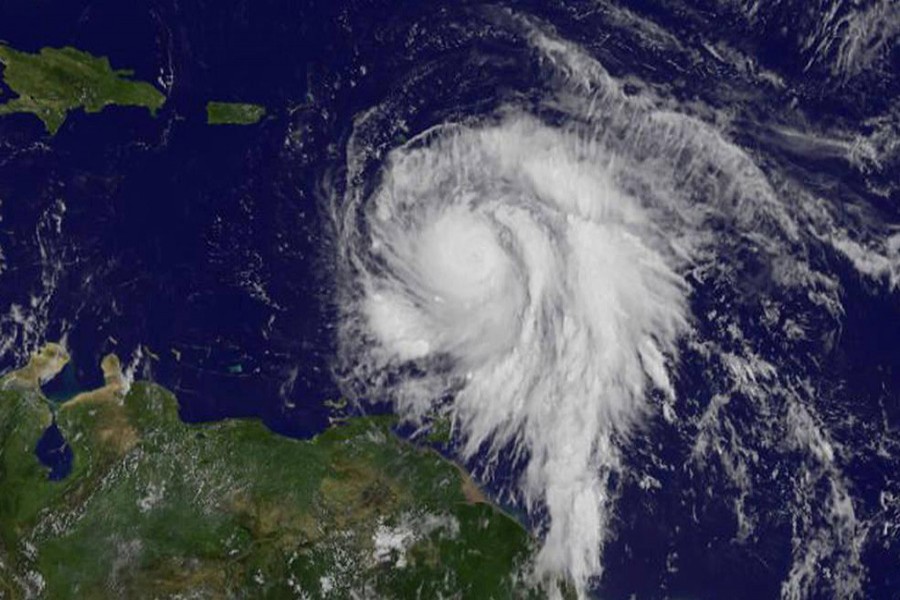The fourth major Atlantic hurricane of the year plowed into the small Caribbean island of Dominica on Monday as a rare, Category 5 storm and will likely bring its roof-ripping winds, torrential rain, and pounding surf later in the week to the US Virgin Islands and Puerto Rico.
Hurricane Maria was upgraded Monday evening to the top of the five-step Saffir-Simpson scale when its maximum sustained winds reached 160 miles per hour (215 km per hour), with higher gusts, the US National Hurricane Center (NHC) reported.
Less than 90 minutes later, the center of the storm, described by the NHC as “potentially catastrophic,” passed almost directly over Dominica, on a track that would put it over Puerto Rico by Wednesday, according to the agency’s latest bulletins.
There was no immediate word on the fate of Dominica, a former British colony home to 72,000 people that lies in the eastern Caribbean about halfway between the French islands of Guadeloupe, to the north, and Martinique, to the south.
But Prime Minister Roosevelt Skerrit, in a Facebook post around the time Maria made landfall, said the storm has blown the roof off his home, adding, “I am at the complete mercy of the hurricane. House is flooding.” He then added, “I have been rescued.”
Millions more in the Virgin Islands and Puerto Rico have another day or two to prepare for the storm.
If Maria retains its strength, it would be the most powerful hurricane to hit Puerto Rico in 85 years, since a Category 4 storm swept the US island territory in 1932, Hurricane Center spokesman Dennis Feltgen said. The last major hurricane to strike Puerto Rico directly was Georges, which made landfall there as a Category 3 storm, he said.
The governor of Puerto Rico, Ricardo Rossello, urged island residents in a social media advisory to brace for the storm’s arrival, saying, “It is time to seek refuge with a family member, friend or head to a state shelter.”
Puerto Rico narrowly avoided a direct hit two weeks ago from Hurricane Irma, which reached a rare Category 5 status and ranked as the most powerful Atlantic storm on record before devastating several smaller islands, including the US Virgin Islands of St. Thomas and St. John.
Residents of some islands fled in advance of the storm.
US Virgin Islands Governor Kenneth Mapp said Maria was due to pass early Wednesday morning within 10 miles of the island of St. Croix, which escaped the brunt of Irma’s Category 5-force fury on Sept. 6 and is home to about 55,000 year-round residents, roughly half of the entire territory’s population.
The territory’s two other main islands, St. Thomas and St. John, which lie to the north of St. Croix, sustained widespread heavy damage from Irma.
Beth Tamplin Jones, 45, rode out Hurricane Irma earlier this month in the pantry of a friend’s house on St. John.
“It was so intense,” said Jones, who evacuated to Puerto Rico last week and then caught a flight to Atlanta, where she planned to remain until Maria passed.
“We’re in hurricane alley, so we’ve had other storms, but nothing like this,” Jones said, referring to Irma, which killed more than 80 people in the Caribbean and the U.S. mainland. “I don’t think anybody’s ever been hit by a storm like that. To see another one coming is just so discouraging.”
Mapp warned residents not to underestimate the threat from Maria. He suggested that for residents who choose their homes over an emergency shelter during the storm, they might consider climbing into a bathtub and pulling a mattress over them to stay safe.
Maria was expected to whip up storm surges - seawater driven ashore by wind - of up to 9 feet (2.7 m) above normal tide levels, the NHC said. Parts of Puerto Rico could see up to 25 inches (64 cm) of rain, it said.
Puerto Rico, an island of about 3.4 million inhabitants, opened shelters and began to dismantle construction cranes that could be vulnerable to Maria’s high winds.
Forecasters also were tracking Category 1 Hurricane Jose, packing 75-mph (120-kph) winds and located about 250 miles (405 km) east of North Carolina, and stirring dangerous surf and rip currents to much of the US Eastern seaboard.
Maria marks the 13th named Atlantic storm of the year, the seventh hurricane so far this season and the fourth major hurricane - defined as Category 3 or higher - following Harvey, Irma, and Jose, the NHC said. Those numbers are all slightly above average for a typical season, which is only about half over for 2017.


